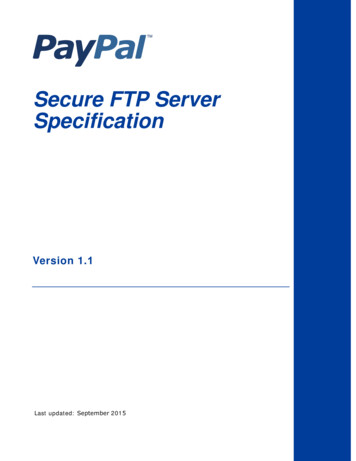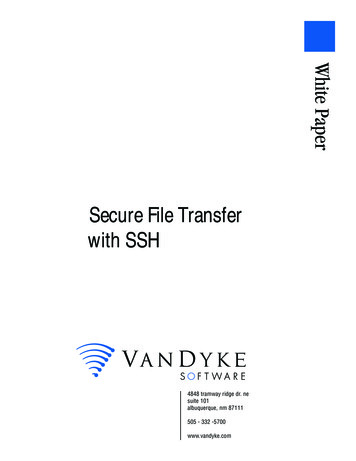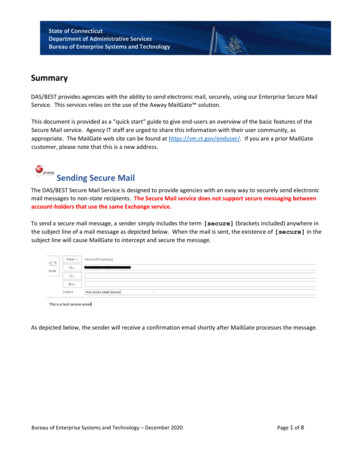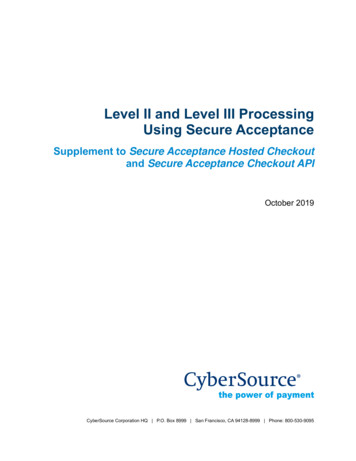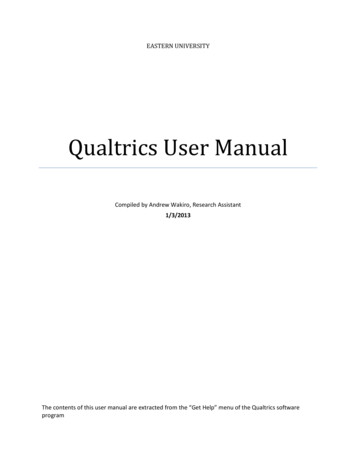
Transcription
A Survey on Perfectly-Secure Verifiable Secret-SharingAnirudh Chandramouli Ashish Choudhury†Arpita Patra‡February 4, 2022AbstractVerifiable Secret-Sharing (VSS) is a fundamental primitive in secure distributed computing.It is used as a building block in several distributed computing tasks, such as Byzantine agreement and secure multi-party computation. In this article, we consider VSS schemes with perfectsecurity, tolerating computationally unbounded adversaries. We comprehensively survey the existing perfectly-secure VSS schemes in three different communication settings, namely synchronous,asynchronous and hybrid setting and provide full details of the existing schemes in these settings.The aim of this survey is to provide a clear knowledge and foundation to researchers who areinterested in knowing and extending the state-of-the-art perfectly-secure VSS schemes.1IntroductionA central concept in cryptographic protocols is that of Secret Sharing (SS) [55, 14]. Consider a setP {P1 , . . . , Pn } of mutually distrusting parties, where the distrust is modeled by a centralizedadversary, who can control up to t parties. Then a SS scheme allows a designated dealer D Pto share a secret s among P, by providing each Pi a share of the secret s. The sharing is donein such a way that the adversary controlling any subset of at most t share-holders fails to learnanything about s, while any subset of at least t 1 share-holders can jointly recover s. In a SSscheme, it is assumed that all the parties including the ones under the adversary’s control follow theprotocol instructions correctly (thus, the adversary is assumed to only eavesdrop the computationand communication of the parties under its control). VSS [18] extends the notion of SS to themore powerful malicious/active adversarial model, where the adversary can completely dictate thebehaviour of the parties under its control during a protocol execution. Moreover, D is allowed tobe potentially corrupted. A VSS scheme consists of a sharing phase and a reconstruction phase,each implemented by a publicly-known protocol. During the sharing phase, D shares its secret in averifiable fashion, which is later reconstructed during the reconstruction phase. If D is honest, thenthe privacy of its secret is maintained during the sharing phase and the shared secret is later robustlyreconstructed, irrespective of the behaviour of the corrupt parties. The interesting property of VSSis the verifiability property, which guarantees that even if D is corrupt, it has “consistently/correctly”shared some value among the parties and the same value is later reconstructed. One can interpret VSS International Institute of Information Technology, Bangalore India. Email: anirudh.c@iiitb.ac.in.International Institute of Information Technology, Bangalore India. Email: ashish.choudhury@iiitb.ac.in. Thisresearch is an outcome of the R & D work undertaken in the project under the Visvesvaraya PhD Scheme of Ministry ofElectronics & Information Technology, Government of India, being implemented by Digital India Corporation (formerlyMedia Lab Asia).‡Indian Institute of Science, Bangalore India. Email: arpita@iisc.ac.in. Arpita Patra would like to acknowledgefinancial support from SERB MATRICS (Theoretical Sciences) Grant 2020 and Google India AI/ML Research Award2020.†1
as a distributed commitment, where, during the sharing phase, D publicly commits to a private input(known only to D) and later during the reconstruction phase, the committed value is reconstructedpublicly (even if D does not cooperate). Due to its central importance in secure distributed-computingtasks, such as secure multi-party computation (MPC) [12, 54] and Byzantine agreement (BA) [30],VSS has been studied in various settings, based on the following categorizations. Conditional vs Unconditional Security: If the adversary is computationally bounded (whereit is allowed to perform only polynomial amount of computations), then the notion of securityachieved is conditional/cryptographic [53, 5, 6], whereas unconditionally-secure VSS providessecurity even against a computationally unbounded adversary. Unconditionally-secure VSS canbe further categorized as perfectly-secure where all security guarantees are achieved in an errorfree fashion [12], and statistically-secure where a negligible error is allowed [54, 25, 40]. Type of Communication: Here we have three categories. The synchronous model assumesthat the parties are synchronized through a global clock and there are strict (publicly-known)upper bounds on the message delays [12, 54, 33, 32, 39, 3]. The second category is the asynchronous model [11, 13, 7, 49, 50, 24], where the parties are not synchronized and where themessages can be arbitrarily (but finitely) delayed. A major challenge in the asynchronousmodel is that a slow sender party (whose messages are delayed) cannot be distinguished froma corrupt sender who does not send messages at all. Due to this inherent phenomenon, asynchronous VSS (AVSS) protocols are more complicated than their synchronous counter-parts.The third category is the hybrid communication setting [51], which is a mix of the synchronousand asynchronous models. Namely, the protocol starts with a few initial synchronous rounds,followed by a completely asynchronous execution. The main motivation for considering a hybrid setting is to “bridge” the feasibility and efficiency gaps between completely synchronousand completely asynchronous protocols. Corruption Capacity: Most of the works on VSS assume a threshold adversary which cancorrupt any subset of t parties. A non-threshold adversary [26, 46, 22, 23] is a more generalizedadversary, where the corruption capacity of adversary is specified by a publicly-known adversarystructure, which is a collection of potentially corrupt subsets of parties. During the protocolexecution, the adversary can choose any subset from the collection for corruption.Our Contributions and Paper Organization We provide a comprehensive survey of all theexisting perfectly-secure VSS schemes tolerating a threshold adversary. We cover three communicationsettings, namely synchronous, asynchronous and hybrid. These schemes are designed over a periodof three decades. The nuances, subtleties and foundational ideas involved in these works need aholistic and unified treatment, which is the focus of this work. This survey is structured to providean easy digest of the perfectly-secure VSS schemes. Through this survey, we hope to provide a clearknowledge and foundation to researchers who are interested in knowing and extending the state-ofthe-art perfectly-secure VSS schemes. The survey is divided into three parts, each dealing with aseparate communication model. We do not survey SS schemes and their share sizes, for which theinterested readers are referred to the survey by Beimel [10].Part I : Synchronous Communication Setting2Preliminaries and DefinitionsThroughout part I, we consider a synchronous communication setting, where the parties in P areconnected by pair-wise private and authentic channels. The distrust in the system is modelled by acomputationally unbounded adversary Adv, who can corrupt at most t parties during the execution2
of a protocol in a malicious/Byzantine fashion and force them to behave in any arbitrary manner.The parties under the control of Adv are called corrupt/malicious, while the parties not under Adv’scontrol are called honest. We assume a static adversary, who decides the set of corrupt parties at thebeginning of a protocol. However, following [41] the protocols discussed can be proved to be secureeven against an adaptive adversary, who can corrupt parties as the protocol proceeds.We also assume the presence of a broadcast channel, which allows any designated party to sendsome message identically to all the parties. A protocol in the synchronous setting operates as asequence of rounds. In each round, a party can (privately) send messages to other parties andbroadcast a message. Moreover in a given round, each party can simultaneously use the broadcastchannel. The messages sent or broadcast by a party is determined by its input, random coins andthe messages received from other parties in previous rounds. The view of a party during a protocolexecution consists of its inputs, random coins and all the messages received by the party throughoutthe protocol execution. The view of Adv is the collection of the views of the corrupt parties.Structure of a VSS Scheme. Following [33], VSS schemes can be structured into two phases. Asharing phase executed by a protocol Sh, followed by a reconstruction phase executed by a protocolRec. While the goal of Sh is to share a secret held by a designated dealer D P, the aim of Rec isto reconstruct back the shared secret. Specifically, during Sh, the input of D is some secret s S,where S is some publicly-known secret-space which is the set of all possible D’s secrets. Additionally,the parties may have random inputs for the protocol. Let viewi denote the view of Pi at the end ofSh. Based on viewi , each Pi outputs a share si , as determined by Sh.During Rec, each Pi reveals a subset of viewi , as per Rec. The parties then apply a reconstructionfunction on the revealed views, as per Rec and reconstruct some output. Following [39], we say thatround-complexity of Sh (resp. Rec) is (R, R′ ), if Sh (resp. Rec) involves total R rounds and amongthese R rounds, the broadcast channel is used for R′ rounds. By communication complexity of aprotocol, we mean the total number of bits communicated by the honest parties in the protocol.2.1DefinitionsA t-out-of-n secret-sharing (SS) scheme is a pair of functions (G, R). While G is probabilistic, R isdeterministic. Function G generates shares for the input secret, while R maps the shares back to thesecret. The shares are generated in such a way that the probability distribution of any set of t sharesis independent of the secret, while any set of t 1 shares uniquely determines the secret.Definition 2.1 (t-out-of-n secret-sharing [34]). It is a pair of algorithms (G, R), such that:– Syntax: The share-generation function G takes input a secret s and some randomness q andoutputs a vector of n shares (s1 , . . . , sn ). The recovery function R takes input a set of t 1shares corresponding to t 1 indices {i1 , . . . , it 1 } {1, . . . , n} and outputs a value.– Correctness: For any s S and any vector (s1 , . . . , sn ) where (s1 , . . . , sn ) G(s, q) forsome randomness q, the condition R(si1 , . . . , sit 1 ) s holds for any subset {i1 , . . . , it 1 } {1, . . . , n}.– Privacy: For any subset of t indices, the probability distribution of the shares correspondingto these indices is independent of the underlying secret. That is, for any I {i1 , . . . , it } def{1, . . . , n}, let gI (s) (si1 , . . . , sit ), where (s1 , . . . , sn ) G(s, q) for some randomness q. Thenwe require that for every index-set I where I t, the random variables gI (s) and gI (s′ ) areidentically distributed, for every s, s′ S, where s ̸ s′ .Definition 2.2. Let Π (ΠG , ΠR ) be a t-out-of-n secret-sharing scheme. Then we say that a value sis secret-shared among P as per Π, if there exists some randomness q such that (s1 , . . . , sn ) ΠG (s, q)and each honest party Pi P has the share si .3
In the literature, two types of VSS schemes have been considered. The type-I VSS schemesare “weaker” compared to the type-II VSS schemes. Namely, in type-II VSS, it is guaranteed thatthe dealer’s secret is secret-shared as per the semantics of some specified secret-sharing scheme1 (forinstance, say Shamir’s SS [55]). While type-I VSS is sufficient to study VSS as a stand-alone primitive(for instance, to study the round complexity of VSS [32] or to design a BA protocol [16]), type-IIVSS schemes are desirable when VSS is used as a primitive in secure MPC protocols [39, 4, 3].Definition 2.3 (Type-I VSS [33]). Let (Sh, Rec) be a pair of protocols for the parties in P, wherea designated dealer D P has some private input s S for the protocol Sh. Then (Sh, Rec) is calleda Type-I perfectly-secure VSS scheme, if the following requirements hold.– Privacy: If D is honest, then the view of Adv during Sh is distributed independent of s.– Correctness: If D is honest, then all honest parties output s at the end of Rec.– Strong Commitment: Even if D is corrupt, in any execution of Sh, the joint view of thehonest parties defines a unique value s S (which could be different from s), such that allhonest parties output s at the end of Rec, irrespective of the behaviour of Adv.Definition 2.4 (Type-II VSS [34]). Let Π (ΠG , ΠR ) be a t-out-of-n SS scheme. Then (Sh, Rec)is called a Type-II perfectly-secure VSS scheme with respect to Π, if the following requirements hold.– Privacy: If D is honest, then the view of Adv during Sh is distributed independent of s.– Correctness: If D is honest, then at the end of Sh, the value s is secret-shared among P asper Π (see Definition 2.2). Moreover, all honest parties output s at the end of Rec.– Strong Commitment: Even if D is corrupt, in any execution of Sh the joint view of thehonest parties defines some value s S, such that s is secret-shared among P as per Π (seeDefinition 2.2). Moreover, all honest parties output s at the end of Rec.Alternative Definition of VSS Definition 2.3-2.4 are called “property-based” definition, wherewe enumerate a list of desired security goals. One can instead follow other definitional frameworkssuch as the the ideal-world/real-world paradigm of Canetti [17] or the constructive-cryptographyparadigm of Liu-Zhang and Maurer [42]. Proving the security of VSS schemes as per these paradigmbrings in additional technicalities in the proofs. Since our main goal is to survey the existing VSSprotocols, we will stick to the property-based definitions, which are easy to follow.2.2Properties of Polynomials Over a Finite FieldLet F be a finite field where F n with α1 , . . . , αn be distinct non-zero elements of F. A degree-dunivariate polynomial over F is of the form f (x) a0 . . . ad xd , where ai F. A degree-(ℓ, m)i ℓ,j mXbivariate polynomial over F is of the form F (x, y) rij xi y j , where rij F. The polynomialsi,j 0defdeffi (x) F (x, αi ) and gi (y) F (αi , y) are called the ith row and column-polynomial respectively ofF (x, y) as evaluating fi (x) and gi (y) at x α1 , . . . , αn and at y α1 , . . . , αn respectively results inan n n matrix of points on F (x, y) (see Fig 1). Note that fi (αj ) gj (αi ) F (αj , αi ) holds for allαi , αj . We say a degree-m polynomial Fi (x) (resp. a degree-ℓ polynomial Gi (y)), where i {1, . . . , n},lies on a degree-(ℓ, m) bivariate polynomial F (x, y), if F (x, αi ) Fi (x) (resp. F (αi , y) Gi (y)) holds.F (x, y) is called symmetric, if rij rji holds, implying F (αj , αi ) F (αi , αj ) and F (x, αi ) F (αi , x).Definition 2.5 (d-sharing [28, 8]). A value s F is said to be d-shared, if there exists a degree-ddefpolynomial, say q(·), with q(0) s, such that each (honest) Pi P holds its share si q(αi )1In Type-I VSS, the underlying secret need not be secret-shared as per the semantics of any t-out-of-n SS scheme.4
(we interchangeably use the term shares of s and shares of the polynomial q(·) to denote the valuesq(αi )). The vector of shares of s corresponding to the (honest) parties in P is denoted as [s]d . A setof values S (s(1) , . . . , s(L) ) FL is said to be d-shared, if each s(i) S is d-shared.2.2.1Properties of Univariate Polynomials Over FMost of the type-II VSS schemes are with respect to the Shamir’s t-out-of-n SS scheme (ShaG , ShaR )[55]. Algorithm ShaG takes input a secret s F. To compute the shares, it picks a Shamir-sharingpolynomial q(·) randomly from the set P s,t of all degree-t univariate polynomials over F whoseconstant term is s. The output of ShaG is (s1 , . . . , sn ), where si q(αi ). Since q(·) is chosenrandomly, the probability distribution of the t shares learnt by Adv will be independent of theunderlying secret. Formally:Lemma 2.6 ([4]). For any set of distinct non-zero elements α1 , . . . , αn F, any pair of valuess, s′ F, any subset I {1, . . . , n} where I ℓ t, and every ⃗y Fℓ , it holds that:hihi⃗y ({f (αi )}i I ) Pr ′ ⃗y ({g(αi )}I I ) ,Prf (x) r P s,tg(x) r P s,t′where f (x) and g(x) are chosen randomly (denoted by the notation r ) from P s,t and P s ,t , respectively.Let (s1 , . . . , sn ) be a vector of Shamir-shares for s, generated by ShaG . Moreover, let I {1, . . . , n}, where I t 1. Then ShaR takes input the shares {si }i I and outputs s by interpolating the unique degree-t Shamir-sharing polynomial passing through the points {(αi , si )}i I .Relationship Between d-sharing and Reed-Solomon (RS) Codes Let s be d-shared througha polynomial q(·) and let (s1 , . . . , sn ) be the vector of shares. Moreover, let W be a subset of theseshares, such that it is ensured that at most r shares in W are incorrect (the exact identity of theincorrect shares are not known). The goal is to error-correct the incorrect shares in W and correctlyreconstruct back the polynomial q(·). Coding-theory [47] says that this is possible if and only if W d 2r 1 and the corresponding algorithm is denoted by RS-Dec(d, r, W ). There are severalwell-known efficient instantiations of RS-Dec, such as the Berlekamp-Welch algorithm [44].2.2.2Properties of Bivariate Polynomials Over FThere always exists a unique degree-d univariate polynomial, passing through d 1 distinct points.A generalization of this result for bivariate polynomials is that if there are “sufficiently many”univariate polynomials which are “pair-wise consistent”, then together they lie on a unique bivariatepolynomial. Formally:Lemma 2.7 (Pair-wise Consistency Lemma [16, 50, 4]). Let {fi1 (x), . . . , fiq (x)} and {gj1 (y), . . . ,gjr (y)} be degree-ℓ and degree-m polynomials respectively where q m 1, r ℓ 1 and wherei1 , . . . , iq , j1 , . . . , jr {1, . . . , n}. Moreover, let for every i {i1 , . . . , iq } and every j {j1 , . . . , jr },the condition fi (αj ) gj (αi ) holds. Then there exists a unique degree-(ℓ, m) bivariate polynomialF (x, y), such that the polynomials fi1 (x), . . . , fiq (x) and gj1 (y), . . . , gjr (y) lie on F (x, y).In type-II VSS schemes based on Shamir’s SS scheme, D on having input s first picks a randomdegree-t Shamir-sharing polynomial q(·) P s,t and then embeds q(·) into a random degree-(t, t)bivariate polynomial F (x, y) at x 0. Each Pi then receives fi (x) F (x, αi ) and gi (y) F (αi , y)from D. Similar to Shamir SS, Adv by learning at most t row and column-polynomials, does not5
learn s. Intuitively, this is because (t 1)2 distinct values are required to uniquely determine F (x, y),but Adv learns at most t2 2t distinct values. In fact, it can be shown that for every two degree-tpolynomials q1 (·), q2 (·) such that q1 (αi ) q2 (αi ) fi (0) holds for every Pi C (where C is the set ofcorrupt parties), the distribution of the polynomials {fi (x), gi (y)}Pi C when F (x, y) is chosen basedon q1 (·), is identical to the distribution when F (x, y) is chosen based on q2 (·). Formally:Lemma 2.8 ([4]). Let C P where C t, and let q1 (·) ̸ q2 (·) nbe degree-t polynomials owhereq1 (αi ) q2 (αi ) holds for all Pi C. Then the probability distributions {F (x, αi ), F (αi , y)}Pi C andno{F ′ (x, αi ), F ′ (αi , y)}Pi C are identical, where F (x, y) ̸ F ′ (x, y) are different degree-(t, t) bivariatepolynomials, chosen at random, under the constraints that F (0, y) q1 (·) and F ′ (0, y) q2 (·) holds.3Lower BoundsIn any perfectly-secure VSS scheme, the joint view of the honest parties should uniquely determinethe dealer’s secret. Otherwise the correctness property will be violated if the corrupt parties produceincorrect view during the reconstruction phase. Since there can be only n t honest parties, tosatisfy the privacy property, the condition n t t should necessarily hold, as otherwise the view ofthe adversary will not be independent of the dealer’s secret. We actually need a stricter necessarycondition of n 3t to hold for any perfectly-secure VSS scheme, as stated in the following theorem.Theorem 3.1 ([29]). Let Π (Sh, Rec) be a perfectly-secure VSS scheme. Then n 3t holds.Theorem 3.1 is first proved formally by Dolev, Dwork, Waarts and Yung in [29] by relating VSSwith the problem of 1-way perfectly-secure message transmission (1-way PSMT) [29]. In the 1-wayPSMT problem, there is a sender S and a receiver R, such that there are n disjoint uni-directionalcommunication channels Ch1 , . . . , Chn from S to R (i.e. only S can send messages to R alongthese channels). At most t out of these channels can be controlled by a computationally unboundedmalicious/Byzantine adversary in any arbitrary fashion. The goal is to design a protocol, whichallows S to send some input message m reliably (i.e. R should be able to receive m without anyerror) and privately (i.e. view of the adversary should be independent of m) to R. In [29], it is shownthat a 1-way PSMT protocol exists only if n 3t. Moreover, if there exists a perfectly-secure VSSscheme (Sh, Rec) with n 3t, then one can design a 1-way PSMT protocol with n 3t, which isa contradiction. On a very high level, the reduction from 1-way PSMT to VSS can be shown asfollows: S on having a message m, acts as a dealer and runs an instance of Sh with input m byplaying the role of the parties P1 , . . . , Pn as per the protocol Sh. Let viewi be the view generatedfor Pi , which S communicates to R over Chi . Let R receives view′i over Chi , where view′i viewiif Chi is not under adversary’s control. To recover m, R applies the reconstruction function as perRec on (view′1 , . . . , view′n ). It is easy to see that the correctness of the VSS scheme implies that Rcorrectly recovers m, while the privacy of the VSS scheme guarantees that the view of any adversarycontrolling at most t channels remains independent of m.An alternative argument for the requirement of n 3t for perfect VSS follows from its reductionto a perfectly-secure reliable-broadcast (RB) protocol over the pair-wise channels, for which n 3tis required [52]. This is elaborated further later in the context of usage of a broadcast channelfor designing VSS protocols (the paragraph entitled ”On the Usage of Broadcast Channel” afterLemma 3.4 and Footnote 2).The Round Complexity of VSS In Genarro, Ishai, Kushilevitz and Rabin [33], the roundcomplexity of a VSS scheme is defined to be the number of rounds in the sharing phase, as all6
(perfectly-secure) VSS schemes adhere to a single-round reconstruction. The interplay between theround-complexity of perfectly-secure VSS and resilience bounds is stated below.Theorem 3.2 ([33]). Let R 1 be a positive integer and let R′ R. Then: If R 1, then there exists no perfectly-secure VSS scheme with (R, R′ ) rounds in the sharingphase if either t 1 (irrespective of the value of n) or if (t 1 and n 4). If R 2, then perfectly-secure VSS with (R, R′ ) rounds in sharing phase is possible only ifn 4t. If R 3, then perfectly-secure VSS with (R, R′ ) rounds in sharing phase is possible only ifn 3t.We give a very high level overview of the proof of Theorem 3.2. We focus only on 2 and R-roundsharing phase VSS schemes where R 3, as one can use standard hybrid arguments to derive thebounds related to VSS schemes with 1-round sharing phase (see for instance [48]). The lower boundfor 2-round VSS schemes (namely n 4t) is derived by relating VSS to the secure multi-cast (SM)problem. In the SM problem, there exists a designated sender S P with some private messagem and a designated receiving set R P, where S R and where R 2. The goal is to designa protocol which allows S to send its message identically to all the parties only in R, even in thepresence of an adversary who can control any t parties, possibly including S. Moreover, if all theparties in R are honest, then the view of the adversary should be independent of m. Genarro etal. [33] establishes the following relationship between VSS and SM.Lemma 3.3 ([33]). Let (Sh, Rec) be a VSS scheme with a k-round sharing phase where k 2. Thenthere exists a k-round SM protocol.The proof of Lemma 3.3 proceeds in two steps.– It is first shown that for any R-round protocol Π, there exists an R-round protocol Π′ with thesame security guarantees as Π, such that all the messages in rounds 2, . . . , R of Π′ are broadcastmessages. The idea is to let each Pi exchange a “sufficiently-large” random pad with every Pjapriori during the first round. Then in any subsequent round of Π, if Pi is supposed to privatelysend vij to Pj , then in Π′ , party Pi instead broadcasts vij being masked with appropriate pad,exchanged with Pj . Since Pj is supposed to hold the same pad, it can unmask the broadcastedvalue and recover vij and process it as per Π.– Let (Sh, Rec) be a VSS scheme where Sh requires k rounds such that k 2. Using the previousimplication, we can assume that all the messages during the final round of Sh are broadcastmessages. Using (Sh, Rec), one can get a k-round SM protocol as follows: the parties invoke aninstance of Sh, with S playing the role of D with input m. In the final round, apart from themessages broadcasted by the parties as part of Sh, every party Pi privately sends its entire viewof the first k 1 rounds during Sh to every party in R. Based on this, every party in R willget the view of all the parties in P for all the k rounds of Sh. Intuitively, this also gives every(honest) party in R the share of every (honest) party from Sh. Every party in R then appliesthe reconstruction function on the n extrapolated views as per Rec and outputs the result. Itis easy to see that the correctness of the VSS implies that if S is honest, then all the honestparties in R obtains m. Moreover, the privacy of the VSS scheme implies that if R containsonly honest parties, then the view of the adversary remains independent of m. Finally, thestrong commitment of the VSS guarantees that even if S is corrupt, all honest parties in Robtain the same output.Next, Genarro et al. [33] shows the impossibility of any 2-round SM protocol with n 4t.Lemma 3.4. There exists no 2-round SM protocol where n 4t.7
By a standard player-partitioning argument [43], Lemma 3.4 reduces to showing the impossibilityof any 2-round SM protocol with n 4 and t 1. At a high-level, the player-partitioning argumentgoes as follows: if there exists a 2-round SM protocol Π with n 4t, then one can also design a2-round SM protocol Π′ for 4 parties, where each of the 4 parties in Π′ plays the role of a disjointset of t parties as per Π. However, one can show that there does not exist any 2-round SM protocolwith n 4 and t 1, thus ruling out the existence of any 2-round SM protocol with n 4t. Werefer the interested readers to [33] for the proof of non-existence of any 2-round SM protocol withn 4 and t 1. Now combining Lemma 3.3 with Lemma 3.4, we get that there exists no VSSscheme with n 4t and a 2-round sharing phase. Since n 3t is necessary for any VSS scheme,this automatically implies that a VSS scheme with 3 or more rounds of sharing phase will necessarilyrequire n 3t.On the Usage of Broadcast Channel All synchronous VSS schemes assume the existence of abroadcast channel. However, this is just a simplifying abstraction, as the parties can “emulate” theeffect of a broadcast channel by executing a perfectly-secure reliable-broadcast (RB) protocol overthe pair-wise channels, provided n 3t holds [52]. RB protocols with guaranteed termination in thepresence of malicious/Byzantine adversaries require Ω(t) rounds of communication [31], while the RBprotocols with probabilistic termination guarantees require O(1) expected number of rounds [30, 38]where the constants are high. Given the fact that the usage of broadcast channel is an “expensiveresource”, a natural question is whether one can design a VSS scheme with a constant number ofrounds in the sharing phase and which does not require the usage of broadcast channel in any ofthese rounds. Unfortunately, the answer is no. This is because such a VSS scheme will imply theexistence of a strict constant round RB protocol with guaranteed termination in the presence of amalicious adversary (the message to be broadcast by the sender can be shared using the VSS schemewith sender playing the role of the dealer, followed by reconstructing the shared message), which isimpossible as per the result of2 [31]. Hence the best that one can hope for is to design VSS schemeswhich invoke the broadcast channel only in a fewer rounds.4Upper BoundsWe now discuss the optimality of the bounds in Theorem 3.2 by presenting VSS schemes withvarious round-complexities. The sharing phase of these schemes are summarized in Table 1 and theirreconstruction phase require one round. The prefix in the names of the schemes denotes the numberof rounds in the sharing phase. In the table, G denotes a finite group and RSS stands for replicatedsecret-sharing [37] (see Section 4.1.4). The 3AKP-VSS scheme has some special properties, comparedto 3FGGRS-VSS, 3KKK-VSS schemes, which are useful for designing round-optimal perfectly-secureMPC protocols (see Section 4.1.7).2This reduction from RB to VSS is another way to argue the necessity of the n 3t condition for VSS, since thenecessary condition for RB is n 3t [52].8
Scheme7BGW-VSS [12]5BGW-VSS [33]4GIKR-VSS [33]3GIKR-VSS [33]3FGGRS-VSS [32]3KKK-VSS [39]3AKP-VSS [3]2GIKR-VSS [33]1GIKR-VSS [33]nn 3tn 3tn 3tn 3tn 3tn 3tn 3tn 4tn 5, t 1Round Complexity(7, 5)(5, 3)(4, 3)(3, 2)(3, 2)(3, 1)(3, 2)(2, 1)(1, e-IIType-IIType-IS
deterministic. Function G generates shares for the input secret, while R maps the shares back to the secret. The shares are generated in such a way that the probability distribution of any set of tshares is independent of the secret, while any set of t 1 shares uniquely determines the secret. Definition 2.1(t-out-of-nsecret-sharing [34]).



